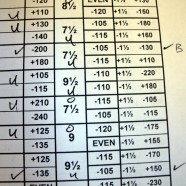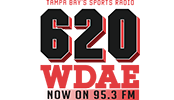Attacking the Runline
I won’t call the runline the most misunderstood bet in sports but it’s definitely a betting option that causes quite a bit of confusion among inexperienced baseball bettors. I’ll assume everyone reading this post already knows what I mean when I say runline however in the case that’s not true, the most concise definition is that the runline is baseball’s version of the point spread (-1.5/+1.5) with juice attached to both sides.
When do people bet the line…
The runline is most commonly bet -1.5 when a team enters the prohibitive favorite range north of -200. Bettors see this as a cheap alternative to back the best pitchers in the game at a price that won’t completely obliterate their bankroll after one loss. There’s one problem with this mentality for a casual bettor; the perceived “value” is actually derived from a mathematical formula connecting moneyline to total so while the price looks cheap, bettors aren’t stealing from books. Oddsmakers know exactly what the price should be and there’s a reason to open the market at a certain price point every time for a -250 home favorite in a game with a posted total of 6.5. However, it is up to the bettor to understand when opportunity exists to take advantage of this position and maximize a wagering opportunity based on his/her handicapping acumen.
Math isn’t on the home favorite’s side…
Let me be one of the first to tell you (if you haven’t heard it already) laying runs with the home team becomes a more dangerous proposition than backing the road team. As it stands, you already only get 9 at bats and if you’re expecting the home side to win by 2+ you will most likely only get 8 plate appearances (11% less) than the home side. Of course teams hit walk off home runs with multiple men on base from time to time but that’s the only way to cover a runline wager headed into the home half of the inning in a tied ball game. Now it should be noted that the prices reflect the difference in home/road math and you’ll see that taking a -220 home favorite in a game with a total of 9 on the runline pays differently than a road favorite in the same price range with the corresponding total.
YTD Runline statistics through June 7
903 Games Played
362 Favorites covered -1.5 Runs compared to 541 underdogs +1.5 Runs, a 40% overall success rate laying runs with the favorite blind.
What these numbers tell me is that if you consistently played the runline, you’d need to take a minimum price of +150 to make this a break even proposition. While this is an overly simplified view under the assumption you’re betting every game blind on the runline, it does reveal that betting the dog (+1.5) cashes 60% of the time. The one problem? Runline dogs aren’t always priced -150 or less, it’s just not that easy.
When do I play the runline…
From my personal experience betting baseball, I find much more success taking the underdog +1.5 instead of laying it. Yes, the same rules of managing juice apply but laying -130 to have +1.5 in your back pocket actually makes quite a bit of sense especially as a % of your normal moneyline betting. Games are played differently late and backdoor covers for runline bettors occur as often as they do for the football faction. You will pay a premium price for runs with lower totals but there’s inherent value in the +1.5 when team totals for both sides are pegged at 3.5 or less. There is no right or wrong way to take advantage of a universal betting option, your same thought process needs to apply to finding betting value. However, don’t be the type of close minded bettor that automatically avoids laying juice with the underdog to grab the runs because you’d be doing yourself a huge disservice.












